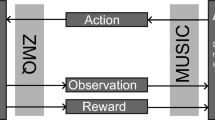Abstract.
This article describes a computational model of the hippocampus that makes it possible for a simulated rat to navigate in a continuous environment containing obstacles. This model views the hippocampus as a “cognitive graph”, that is, a hetero-associative network that learns temporal sequences of visited places and stores a topological representation of the environment. Calling upon place cells, head direction cells, and “goal cells”, it suggests a biologically plausible way of exploiting such a spatial representation for navigation that does not require complicated graph-search algorithms. Moreover, it permits “latent learning” during exploration, that is, the building of a spatial representation without the need of any reinforcement. When the rat occasionally discovers some rewarding place it may wish to rejoin subsequently, it simply records within its cognitive graph, through a series of goal and sub-goal cells, the direction in which to move from any given start place. Accordingly, the model implements a simple “place-recognition-triggered response” navigation strategy. Two implementations of place cell management are studied in parallel. The first one associates place cells with place fields that are given a priori and that are uniformly distributed in the environment. The second one dynamically recruits place cells as exploration proceeds and adjusts the density of such cells to the local complexity of the environment. Both implementations lead to identical results. The article ends with a few predictions about results to be expected in experiments involving simultaneous recordings of multiple cells in the rat hippocampus.
Similar content being viewed by others
Author information
Authors and Affiliations
Additional information
Received: 25 June 1999 / Accepted in revised form: 20 March 2000
Rights and permissions
About this article
Cite this article
Trullier, O., Meyer, JA. Animat navigation using a cognitive graph. Biol Cybern 83, 271–285 (2000). https://doi.org/10.1007/s004220000170
Issue Date:
DOI: https://doi.org/10.1007/s004220000170




